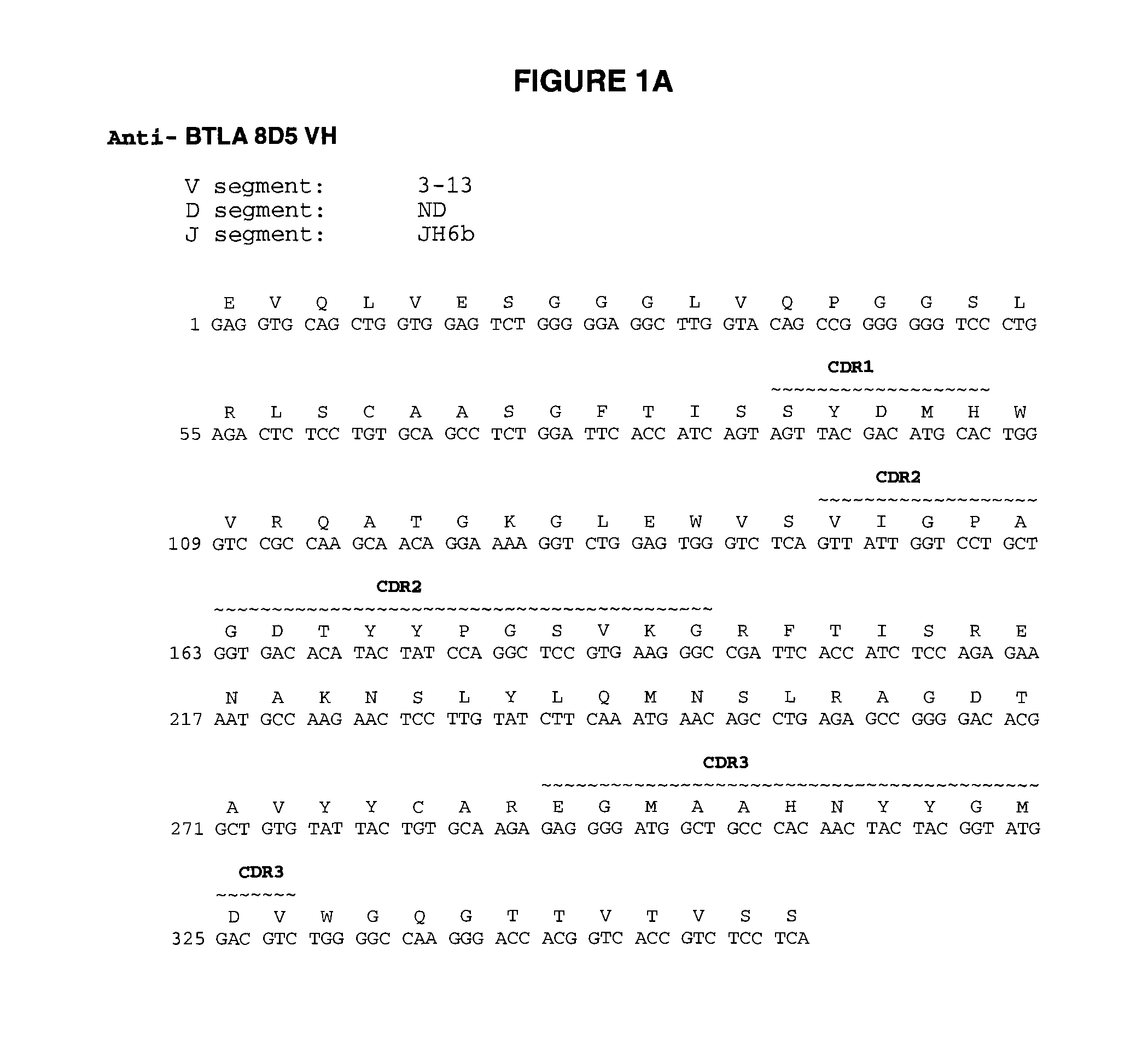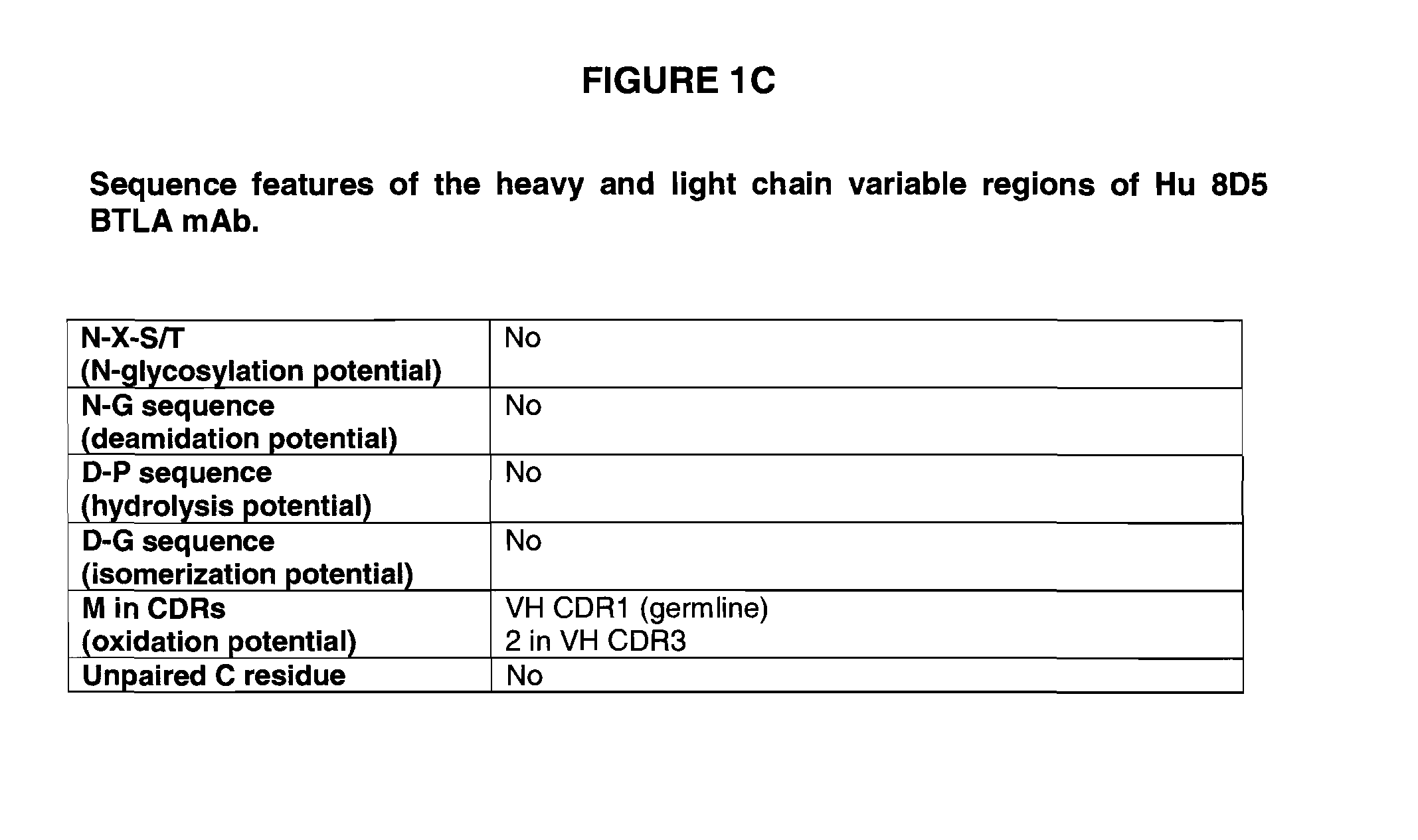Fully human antibodies to BTLA
a technology of human antibodies and btla, which is applied in the field of antibodies or antigen binding fragments, can solve the problems of insufficient magnitude of immune responses directed against different antigens, undesired immunogenicity of antibodies, and inability to afford protection against disease processes mediated by agents, and achieves good pharmacokinetics, high binding affinity, and neutralizing activity
- Summary
- Abstract
- Description
- Claims
- Application Information
AI Technical Summary
Benefits of technology
Problems solved by technology
Method used
Image
Examples
example 1
Fully Human BTLA Antibodies
[0398]Fully human monoclonal antibodies specific for human BTLA were generated using Medarex, Inc.'s UltiMAb antibody generation platform by immunizing mice with a combination of CHO cells overexpressing membrane-bound huBTLA and huBTLA-Fc fusion protein in MPL®+TDM adjuvant. Mice were immunized with BTLA-Fc fusion protein or cells expressing membrane-bound BTLA expressing mature extracellular domain (residues 31-152 of SEQ ID NO: 35). This sequence corresponds with the extracellular domain of transcript 1 variant described at GenBank Accession No. NP—861445 sequence (that matches human BTLA transcript 1 variant (NP—861445), with one amino acid difference in the intracellular domain at position 267 ((Pro267Leu, SEQ ID NO:35, encoded by SEQ ID NO:36) relative to NP—861445 (SEQ ID NO:37). After multiple rounds of immunization and serum titering, selected mice were chosen for fusion. One fusion produced 49 anti-BTLA Mabs most of which were of the IgG4 isotype...
example 2
Anti-BTLA Antibody Binding Affinities
[0403]Cell-based flow cytometry was used to determine apparent binding affinities of hu Mab8D5 (FIGS. 3A-B) and hu Mab4C7 to human and cynomolgus BTLA (FIGS. 3C-D). Half-maximal binding of human and cynomolgus BTLA occurred at ˜12 nM for both the IgG1 and IgG4 versions of hu Mab8D5. For agonist binding analysis (FIGS. 3A-B), hu Mab8D5 was titrated 3-fold from 20 μg / ml on CHO cells expressing human BTLA or 2-fold from 50 μg / ml on CHO cells expressing cynomolgus BTLA in 4° C. buffer containing 0.02% sodium azide to prevent receptor internalization. PE-anti-huFc was used for detection. This data illustrates that hu Mab8D5 binds to human and cynomolgus BTLA. Agonists huMab8A3, hu Mab21H6, and hu Mab19A7 exhibit similar binding affinities to that of hu Mab8D5.
[0404]
TABLE 5BIAcore ResultsKD × 10−9kon × 104koff × 10−4Clone ID(M)(1 / Ms)(1 / s)8D5 (G4) agonist2.994.581.3721H6 (G1)5.505.112.828A3 (G1)9.272.885.9619A7 (G1)20.72.885.96
[0405]For antagonist bindi...
example 3
BIAcore
[0406]The antibodies were further profiled in order to elucidate binding kinetics and calculate equilibrium binding constants using BIAcore analysis demonstrating fast-on slow-off kinetics. For BIAcore, the test antibodies were captured on an anti-CH1 chip.
[0407]Hu Mab8D5 G4 exhibited an apparent Kd of 2.4 nM. The antagonist antibody hu Mab4C7 exhibited an apparent Kd of 4.6 nM.
[0408]
TABLE 6BIAcore ResultsHuMAbKa (1 / Ms) * (104)Kd (1 / s) * (10−4)KD (nM)8D5 (G4) agonist7.91.92.44C7 antagonist9.254.34.6
PUM
| Property | Measurement | Unit |
|---|---|---|
| molecular weight | aaaaa | aaaaa |
| molecular weight | aaaaa | aaaaa |
| molecular weight | aaaaa | aaaaa |
Abstract
Description
Claims
Application Information
 Login to View More
Login to View More - R&D
- Intellectual Property
- Life Sciences
- Materials
- Tech Scout
- Unparalleled Data Quality
- Higher Quality Content
- 60% Fewer Hallucinations
Browse by: Latest US Patents, China's latest patents, Technical Efficacy Thesaurus, Application Domain, Technology Topic, Popular Technical Reports.
© 2025 PatSnap. All rights reserved.Legal|Privacy policy|Modern Slavery Act Transparency Statement|Sitemap|About US| Contact US: help@patsnap.com



